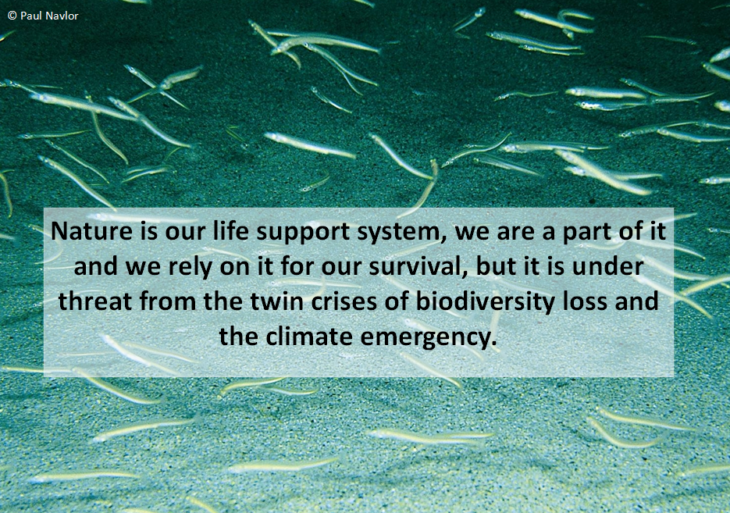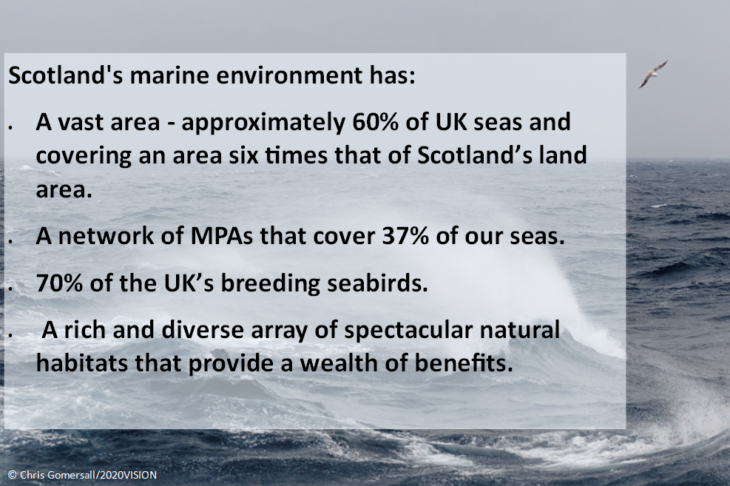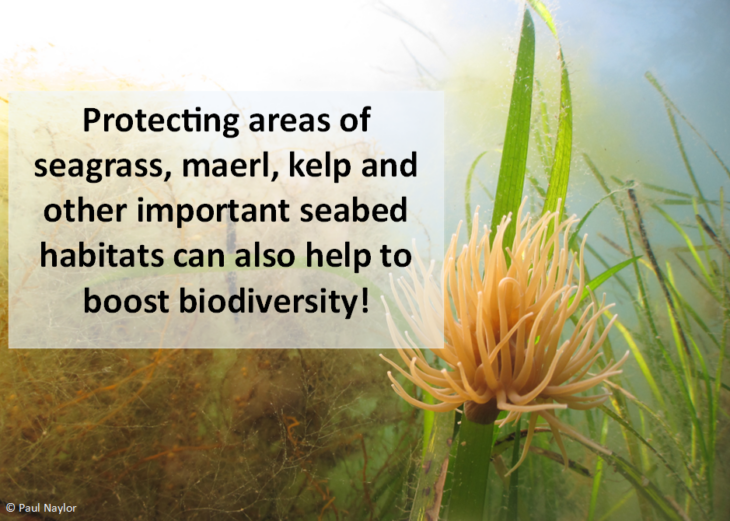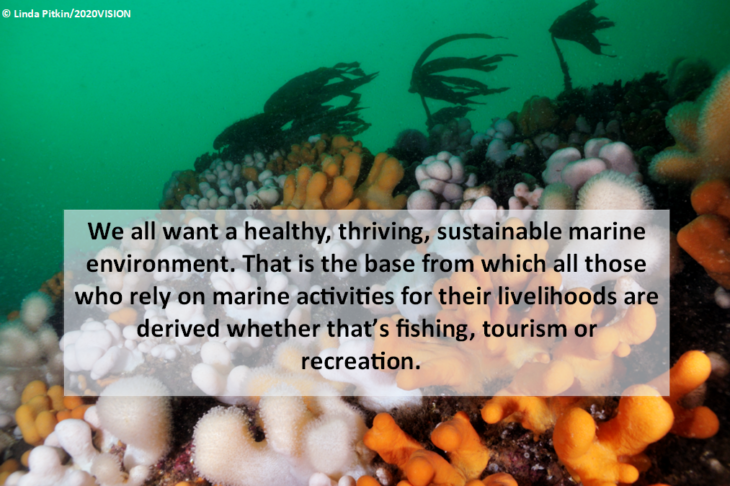Holistic marine management – the need for Highly Protected Marine Areas
While questions are being raised about Highly Protected Marine Areas (HPMAs) the Scottish Wildlife Trust’s Living Sea’s team have set out to highlight how they fit into the existing marine protected areas network and their benefits which will hopefully resolve some common misconceptions.
What are Highly Protected Marine Areas (HPMA’s)?
Marine Protected Areas (MPAs) are like the national parks that you find on land, but they protect areas of our marine environments including all of the marine plants, animals, and habitats. Highly Protected Marine Areas (HPMAs) are a type of MPA that offer the strictest level of environmental protections. In other countries, these are often called “no-take zones”, which have been successfully established in countries such as the USA, New Zealand and Australia. The Great Barrier Reef in Australia is perhaps the most well-known example of a “marine park” that includes a network of no take zones, which are also known there as green zones. Within the green zones recreational activities like boating, swimming and diving are permitted whereas fishing and coral collecting are prohibited. The Great Barrier Reef is one of the most complex and diverse ecosystems in the world and the network of no take zones allows for management that supports both the environment and economy of the area, with some commercial or sport fishing allowed within certain areas of the park.

What is the status of HPMA’s in Scotland?
Scottish ministers made a pledge to designate at least 10% of Scotland’s seas as Highly Protected Marine Areas (HPMA’s) by 2026 in the Bute House Agreement – an agreement between the Scottish Government and the Scottish Green Party – which would bring us in line with other international commitments to marine ecosystem recovery. The Scottish Government held a consultation on HPMA’s between December 2022 and April 2023.
There has been a lot of controversy surrounding HPMAs in recent weeks with opposition from across the political spectrum and from fisheries representatives on the impacts HPMAs could have on coastal communities.
So why do we need HPMA’s if we already have Marine Protected Areas?
Scotland currently has a Marine Protected Areas (MPA) network with 233 nature conservation sites that cover 37% of our seas. But this network often fails to prevent even the most destructive activities taking place such as bottom trawling or scallop dredging, where rigid structures are towed across the seabed and can decimate huge areas of marine life in their wake. It has been well documented in numerous studies just how damaging this form of fishing is to the marine environment. For example, a study published in Nature in 2021 highlighted the importance of stricter protection areas in our oceans to improve biodiversity and climate mitigation. We know very little about marine sediments and their ability to capture carbon, in a climate emergency we should be adopting a precautionary approach to sea bed disturbance.
In 2010, under the UN Convention on Biological Diversity the international community pledged to protect 10% of oceans by the end of 2020. However, by 2020 this target had not been met with only 7.6% of oceans designated as MPAs. There are now calls to go further by protecting 30% of our oceans by 2030 (sometimes referred to as 30×30) recognising that the stability of our oceans controls all living systems on earth, and we must do more to protect nature and ourselves from the twin biodiversity and climate crises. HPMA’s would provide stricter protection to help fragile or damaged ecosystems to recover, mitigate the effects of climate change, improve biodiversity and strengthen the current network while allowing for “non-damaging” activities such as swimming.

What are the benefits of HPMAs?
The benefits of strict protections for marine life are well documented across the world. For example, a decade after the Cabo Pulmo protected areas in the Gulf of California were established by the local community, fish biomass had increased by 460%. The protection of these areas also allowed for the wider biodiversity to thrive including whale sharks, manta rays, humpback whales and endangered sea turtle populations. Eco tourism is also thriving within the park as a result of the marine protections, the pristine environments attracting both snorkellers and divers.
In the UK, there are four small areas designated as ‘no-take zones’. Here in Scotland, the community-led no-take zone in Lamlash Bay in the Isle of Arran is a brilliant example of strict protection similar to that proposed for HPMAs which has shown great successes over the last decade. Since 2010, biodiversity in the no-take zone has increased by 50%. Within the zone, the commercially valuable scallop population has recovered and the lobster population has more than quadrupled, with lobsters growing bigger and producing more eggs. But these benefits can extend beyond the borders of these zones. Fishermen have reported that catches on the edge of the no-take zone have significantly increased. This is a phenomenon commonly referred to as the “spill over effect” which can have benefits to local fishers from even very small areas of strict protection by contributing to the replenishment and maintenance of species targeted by fisheries. Protecting areas of seagrass, maerl, kelp and other important seabed habitats can also help to boost biodiversity as they are important nursery habitats whole range of species, including commercial fish.

HPMAs and Local Communities
One of the key learnings from the Trust’s Oceans of Value Community Voice Method film in Orkney is that there was a common feeling amongst all interviewees that it is important to have a healthy, thriving, sustainable marine environment. That is the base from which all those who rely on marine activities for their livelihoods are derived whether that’s fishing, tourism or recreation.
It was also clear from interviewees that early consultation and meaningful engagement with communities will be essential in achieving the greatest benefits from marine management measures like HPMAs and improving the health of Scotland’s Seas. Ensuring that local communities are consulted and have a core role in designating HPMAs is crucial for these sites to have a significant positive impact on the environment and coastal communities. First Minister Humza Yousaf has assured MSPs that policies will not be imposed “on communities that don’t want them” and reiterated that HPMAs are still at a very early stage with criteria and site selection to be decided based on the recently closed consultation in April, with a further consultation on proposed sites in 2025. The Trust submitted a response to the recent consultation, advocating for an approach to site designation that involves listening to communities and recognising the benefits stricter ocean protections can bring to nature and people alike.

The Scottish Wildlife Trust’s position
The Trust’s Strategy 2030 goals are focused on both protecting and restoring ecosystems as well as connecting people with nature. The designation of HPMAs will go some way to helping achieve these goals with a more sustainable future for Scotland’s marine environment. We support the provision for “at least” 10% of Scotland’s seas being protected as outlined in our Nature Recovery Plan. Nature is our life support system, we are a part of it and we rely on it for our survival, but it is under threat from the twin crises of biodiversity loss and the climate emergency. The designation of HPMAs could play a vital role in addressing these crises where they are used as a tool within a suite of other measures such as marine spatial planning. This would help to achieve a holistic approach to managing the competing uses of the marine environment and protecting it for nature, for us and for future generations to come.
For further reading on this topic see the Evidence Base Briefing on HPMAs from Scottish Environment LINK.
Help protect Scotland’s wildlife
Our work to save Scotland’s wildlife is made possible thanks to the generosity of our members and supporters.
Join today from just £4 a month to help protect the species you love.
Preface
While questions are being raised about Highly Protected Marine Areas (HPMAs) the Scottish Wildlife Trust’s Living Sea’s team have set out to highlight how they fit into the existing marine …
